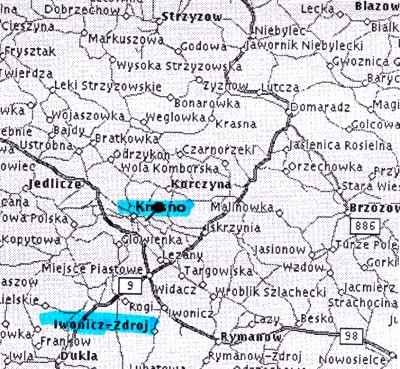 |
|
|
[Page 287]
Translated by William Leibner
|
|
| The spa center Iwonicz–Zdroj is located south of Krosno and north of Dukla |
The spa center of Iwonicz–Zdroj , better known as Iwonicz is located in the Krosno province. It is situated 16 kilometers south of the city of Krosno and 80 kilometers south of Rzeszow, Galicia, Poland. The place is located about 400 meters above sea level and surrounded by hills covered with trees. Already in 1578 it was known as a health spa. Iwonicz contained a variety of mineral waters and mud baths that helped people. The place developed and became a leading health spa center in Poland, especially Galicia. In the summer and to a certain extent in the winter, many well to do people spent their vacations in Iwonicz. Some people even built summer homes in the area. The number of health establishments kept growing. Iwonicz had a small population of about 2,000 people during the year but this number greatly increased during the summer or winter vacation seasons.
|
|
| The summer and winter resort home of the Akselrad family in Iwonicz–Zdroj about 16 kilometers from Krosno |
In 1785 we find 18 Jews in Iwonicz and by 1921 there are 61 Jews in the hamlet. The Jews in Iwonicz were under the supervision of the Jewish community of nearby Dukla. There was a small Jewish community in Iwonicz that grew with time. According to Batia Akselrad, her father helped built the synagogue in Iwonicz where rabbis like Shmuel Fuhrer or Moshe Twerski prayed when on vacation in Iwonicz. Many hotels provided religious services within their premises for the orthodox Jews. With time, Jewish shops like butcher shops, bakeries, fish stores and restaurants opened to provide the needs of the Jewish population especially during the tourist seasons.
Many Krosno Jews spent their vacations in nearby Iwonicz, notably rabbi Moshe Twerski or the Akselrad family. Iwonicz also had Jewish families that lived permanently the hamlet amongst them the Glazier and the Lusthaus families. Edmund Lusthaus was a physician and his wife Helena studied pharmacology prior to the war. The latter were assimilated Jews who spoke only Polish. The Lusthaus family survived the war. Edmund was drafted into the Polish army and taken prisoner by the Russians in 1939, where he later joined the Polish Army that left Russia and fought with the Allies. Helena Lusthaus and her daughter, Elizabeth, managed to reach Tarnow where they
|
|
| Bended Akselrad, head of the Krosno Jewish community, drinking the mineral water at the Iwonicz spa |
|
|
| Strolling in the spa center of Iwonicz From left, Bendet Akselrad, head of the Jewish community in Krosno; Rabbi Moshe Twerski, Hassidic rabbi of Krosno; and a close follower of the rabbi |
|
|
| Rabbi Moshe Twerski, second from left, with Hasidic entourage in the resort spa of Iwonicz–Zdroj |
had family. Mrs. Lusthaus worked as a pharmacist for the Germans and managed to obtain “Aryan” papers for herself and her daughter that saved them. They were eventually liberated by the Russian army and left Poland. The entire family met in Italy where Edmund was stationed with the Polish Army.
Here is what Dora Beinfish–Cohn, a resident of Krosno and Iwonicz, had to say about Iwonicz–Zdroj. “We lived in Krosno in a large house. My father was an engineer. The family acquired a big parcel of land from the ‘Chrabia,’ or Count Zatuski who owned a good part of Iwonicz but was always short of cash. The family decided to build a 44–room hotel named the ‘Bristol’ and 2 apartment buildings with stores on the ground floor. The entire project was finished in 1939 just before the beginning of the war. The family moved to Iwonicz.”
On entering Iwonicz the Germans converted the hotel to a military hospital. They soon ordered all the Jews to leave the spa center and proceed to the Ghetto of Rymanow. The Germans forced most of the Jews of Rymanow to cross the border to the Russian–controlled part of Poland. Some Jews disobeyed the order by hiding and then reappeared in Rymanow. They were also joined by some Jews who returned from the Russian controlled areas. In August of 1942, most of the Jewish men were rounded up and sent to the concentration camp of Plaszow, near Krakow in Poland. On August 13, 1942, all the Jews of Rymanow were assembled and sent by train to the death camp of Belzec.
Dora Fishbein–Cohn survived the war due to the extensive support she received from the Zatuski family at the beginning of the German occupation. Later she was assisted and protected by Mrs. Dunajewski and the Kazarski family in the village of Wola Komborska.
Another small Jewish community was devastated without leaving a trace of Jewish existence in Europe.
|
|
JewishGen, Inc. makes no representations regarding the accuracy of
the translation. The reader may wish to refer to the original material
for verification.
JewishGen is not responsible for inaccuracies or omissions in the original work and cannot rewrite or edit the text to correct inaccuracies and/or omissions.
Our mission is to produce a translation of the original work and we cannot verify the accuracy of statements or alter facts cited.
 Krosno, Poland
Krosno, Poland
 Yizkor Book Project
Yizkor Book Project
 JewishGen Home Page
JewishGen Home Page
Copyright © 1999-2025 by JewishGen, Inc.
Updated 13 Mar 2015 by JH